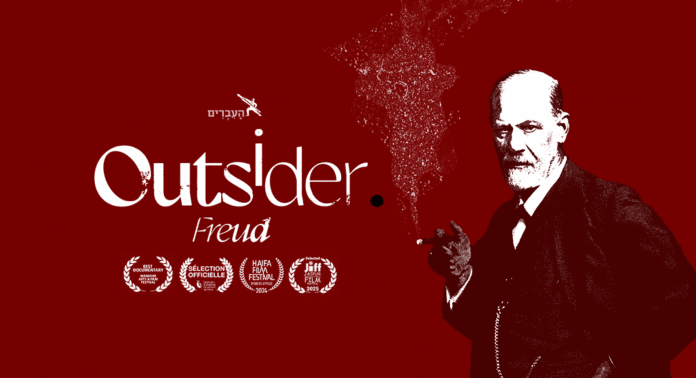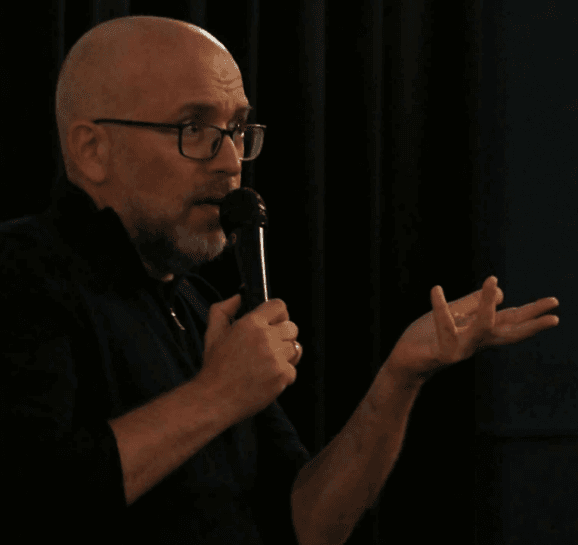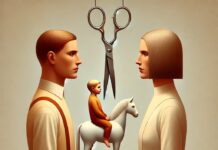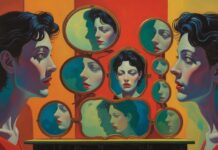If, while walking through the streets of Prague’s city centre (and more specifically on Husova Street, dedicated to the Czech Protestant reformer Jan Hus), you happened to lift your gaze, diverting it for a few seconds from your mobile phone, you might see a strange, unsettling figure suspended in the rectangle of sky that separates two buildings. It could appear, like a ghost, above you. At first glance, you might be startled and led to think it’s a person hanged or in danger. However, after a few moments, you will quickly realise it’s the work of a sculptor depicting a man hanging with his right hand from a protruding beam. The other hand is calmly resting in his trouser pocket. Looking even closer, you might also recognise the man’s face. Almost completely bald, he wears a pair of round glasses, and his chin and cheeks are covered with a thick, well-groomed beard. His expression is serious yet serene. Without a doubt, it is Sigmund Freud.

The statue is the work of the Prague sculptor David Černý and was created in 1996 under the title Viselec or Zavěšený muž (literally „Hanging Man“ or „Suspended Man“). According to the artist, it is “a reflection on the arrival of the new millennium and on what would happen next. Freud is a symbol of the intellectualism of the previous century.” The way Černý views Freud and his thoughts remains an enigma. But looking at it from below, this real or simulated hanging seems to weigh heavily on passersby. Only those who choose to can learn more and perhaps realise that this is an intellectual suspended like the sword of Damocles above the busy everyday life below. Freud supports himself with one hand on one of those beams typical of large constructions. The word “hand” comes from the Indo-European root “ma”, meaning measure, computation, and construction. The hand is the intellectual organ capable of building Thought. Perhaps Černý intended to depict Freud at the height of his thinking, able to support himself effortlessly with the intellectual organ par excellence?
On September 20, 2025, in the “Theatre Behind the Fence” located within the psychiatric hospital of Bohnice[1], in the northern outskirts of Prague, the new documentary film about Sigmund Freud, Outsider, by Israeli director Yair Qedar, was screened. The event, organised in collaboration with the group Psychoanalysis Today[2] and the Czech Psychoanalytic Society[3]was completely sold out, with nearly 150 people in attendance, drawn especially by the presence of the director, who introduced and commented on the film, answering questions from the organisers and the audience.
After the usual thanks, the director stated he was happy “to have brought Freud home” (Freud, it should be remembered, was born in the city of Freiberg, now called Příbor, in Moravia). The Israeli director emphasised two aspects to pay particular attention to during the screening of the film. First, the animation. The film, Yair said, “the film is very visual.” In fact, everything revolves around the reconstruction of Freud’s legendary therapy room on Berggasse Street in Vienna, which was recreated through computer graphics, using more than 100 photographs taken by Edmund Engelman in 1938, when the photographer secretly entered Freud’s apartment at the risk of being arrested by the Gestapo.
Secondly, dreams. Yair said, “I didn’t want to make a film about Freud without dreams, so I asked myself how I could represent them.” Adding: “Freud described a total of 86 dreams (his own or those of patients he treated). Some of them are very short and personal. I started looking for dreams that had remained without interpretation, and I found a few in The Interpretation of Dreams”.
Yair quotes several dream fragments from The Interpretation of Dreams, mixing them as if they formed a single dream. He then contacted an Israeli graphic artist, with whom he worked for an entire year on the visual realisation: “All four chapters of the film begin with the representation of a dream described by Freud, and at the end, we have ‘the dream of dreams.“
After the screening, the director spoke in more detail about the making of the film and some of its key elements. Yair said he began this project six years ago as part of The Hebrews[4], a series in which he explores the lives of Jewish and Israeli figures from the modern Jewish literary canon. He also revealed that he tested analysis on himself (four times a week) to better understand the subject matter.
He offered an interpretive framework for the film through four “challenges” that Freud faced throughout his life:
- The question of Jewish identity.
- The processing of his father’s death and the invention of psychoanalysis.
- The mourning of further losses (the deaths of his daughter, grandson, and mother).
- The transcendence of life (his battle with cancer starting in 1923).
“The film,” Yair says, “makes extensive use of quotations taken directly from Freud’s letters — of which there are over 30,000 in German alone.”
An interesting anecdote involves the fact that the director initially tried to use Artificial Intelligence to group some of Freud’s letters, only to discover that the letters the AI found were completely fabricated! However, this experience led him to discover letters that particularly highlighted Freud’s human side, such as when he confided to Fliess that he didn’t attend his mother’s funeral.
The footage of Freud shown in the documentary comes mainly from the Marie Bonaparte archive. Once again, the director was fascinated by a more intimate version of Freud, such as when he is seen playing with dogs or affectionately embracing his children and grandchildren.
Speaking about the archive, the director distinguishes between the domestic Freudian archive (composed mainly of letters) and that of Princess Bonaparte, which consists of a visual memory (photos, videos, making up about 90% of the material) and a documentary and preservation memory (writings, objects, letters, etc.), in some cases even going against Freud’s own wishes. In addition to this, there is an archive of symbolic images that the director mainly found in Amsterdam, in a collection of films made by unknown filmmakers, which, according to him, blend very well both with the themes addressed in the film and with the early 20th-century imagination.
While the photos show a serious, posed Freud, the director says, “the amateur videos offer a chance to observe Freud in a more domestic and informal setting, in the company of dogs and children.” One particularly moving moment for the director, he said, was the instant when he “saw him smile for the first time.”
On the importance of Princess Marie Bonaparte, Yair explains that it lies in the fact that Freud’s archive remained sealed for 40 years. “Marie Bonaparte saved Freud from being captured by the Nazis, preserved his visual memory through amateur films, and rescued many documents, sometimes against Freud’s will, by retrieving them from the trash or buying them at auction, as was the case with the correspondence between Freud and Fliess.”
The director also speaks about the choice of the train as a leitmotif throughout the documentary, explaining that the train is an element deeply connected to both Freud and psychoanalysis for several reasons. First, as a symbol of innovation and progress (along with electrification), it allowed large-scale transport of people from various social backgrounds. The train was also Freud’s preferred means of transport, and it is at the centre of several important events in his life, some of which are depicted in the film, such as the antisemitic incident he was subjected to, or when he was forced to divide his family into two different trains. The train is also, Yair added, “a phallic symbol and a reminder of the Holocaust.”
After the screening of the film, a representative from the group Psychoanalysis Today, Tomáš Kufa, asked the director a few questions.
Tomáš: The film presents various metaphors for Freud, the genius, the misunderstood outsider, the ordinary man. In a way, you chose ‘the genius’ oops, I meant… ‘the outsider’ as the title of the film? You see, slips of the tongue are everywhere!” [audience laughs] “Anyway, if you could meet one of these Freuds, which one would you choose? The outsider, the genius, or the ordinary man? You invited us, through the film, into the places where Freud lived, worked, and moved… which place would you choose for your meeting with him?
Yair: I think I’d choose the outsider. And regarding the title of the film, it came from the second letter quoted in the film, the one where the train incident is described, where someone asks Freud to close the window, calling him a ‘dirty Jew,’ and he refuses to do it. Then the conductor reminds him that ‘in winter, windows must remain closed,’ and so Freud closes it. I thought that letter was incredibly powerful. Later, Freud writes to Martha (though I didn’t include this part in the film): ‘In the past, I used to be very upset by things like this, but now I’m completely used to it.’ That led me to wonder: ‘How did the antisemitic man even know that Freud was Jewish? And how did Freud respond to him?’
You have to go back to the early story involving Freud’s father, when someone knocks off his hat and he picks it up without reacting. And then, how did Freud respond to the conductor? So, I’d really like to be on that train with Freud. As an Israeli, a Jew, and a member of the queer movement, what would I say if someone called me ‘dirty…’ on that train? Would I get used to something like that? Absolutely not! So, I think I’d be happy to sit next to him, and I believe that this captures the meaning of the word Outsider.
At the same time, the film also gave me the chance to carry Freud with me, inside me, because Freud is also an Insider. Especially when we look at things through a Freudian lens.

Tomáš Kufa: You said this is just one of many possible films about Freud. Were there any figures or themes you were forced to leave out? Could you give us a few examples?
Yair: Not many, but a few, yes. For example, Anna Freud, the daughter, or Amalia, his mother, and even Martha, his wife. Also, as Adam Phillips wrote, Freud’s childhood was mainly narrated by Freud himself. He was a child growing up in a time when antisemitism was widespread, which may have deeply influenced his desire for social and professional revenge.
It would be very interesting to explore more deeply the figure of his mother, who lived in his apartment for so many years and is rarely mentioned. Another aspect is the sexuality of his daughter Anna, a very intriguing topic. It has been said that Anna was asexual. She underwent analysis with her father but then had a long career and lived much longer than he did. Apparently, she wasn’t lesbian, but asexual. Yet later, she became part of a movement that was responsible for persecuting gay people, especially in the United States.
It’s very interesting that someone who denied their own sexuality could go on to promote homophobia. That’s a chapter I had to leave out, but maybe I’ll dedicate a separate film to it.
Lucien Zell: I really liked the ending of the film; I found it memorable: ‘There are no men or women who are simple.’ I wanted to ask you: did you consider other possible endings? And why did you choose this one?
Yair: Absolutely. You know, when you’re working on a film, you have many stories, many endings, many beginnings. But in making a film, the most critical parts are the beginning and the end. You can relax and even enjoy yourself working on the core, the middle part of the film, but when it comes to the ending, you must be very careful.
I think there’s an element of irony in this film. At the beginning, Freud says, ‘I’m not a genius,’ and at the end, we hear about ‘an ordinary man who could have simply been an optician.’ So you see, there’s a kind of irony both at the beginning and the end. Also, Freud is such a well-known figure that he’s almost automatically consumed… I wanted to challenge that automatism in the way Freud is received.
Another intellectual exercise I tried to do was to forget Freud’s legacy and everything that was discovered after him. It was as if I tried to capture Freud in a single moment. Interesting… I hadn’t thought about it that way before.
Audience member: You mentioned that Freud didn’t attend his mother’s funeral. I wanted to ask you why, if you’ve come up with an explanation or what your emotional reaction was to that?
Yair: I asked one of the leading Freud experts who appears in the film, Christian Tögel, and he told me that Freud considered ceremonies to be fake, insincere. That also tells us something about his relationship with being an Orthodox Jew.
In the end, I too managed to ask Yair a question, first thanking him for having the courage to make a film about Freud in 2025, something that, from my perspective, was both necessary and courageous. I then asked him whether he could share something about Freud’s legacy and the future of psychoanalysis; whether making the film helped him understand where the discipline is headed, and why it was important for him to create a film about Freud at this specific historical moment.
Yair: What I’ve been doing over the past few years is a project called The Hebrews, a documentary series about prominent Jewish and Israeli writers. Initially, I hadn’t thought about making a film on Freud. I was reading articles that even discussed the idea of ‘cancelling’ Freud, for example, in the United States, and that worried me quite a lot. I started travelling, did some research, and I was very surprised and happy to discover that Freud has not been cancelled at all. In fact, he’s come back into the spotlight, mainly in Literature and Humanities departments rather than in Psychology. So, once I confirmed that there was still real interest in Freud, I tried to find out which topics were being explored in connection with him and his work. That’s how I found courses on Freud addressing themes like gender identity, minorities, marginalisation, and so on.
I filmed until September 2023 and started editing in October of the same year. And of course, everyone knows what happened in October 2023. It was something that had to do with death. Personally, I believe we have entered an age of death, where everything is surrounded by death and destruction. But all this also ties into Freud’s own investigation and his way of approaching death.
So, this is how the film took shape, and it also references Freud’s death models, his responses to mortality. Of course, we know there isn’t much optimism in Freud’s thinking about death, but there is a beautiful letter from Freud at the end of the film[5], which speaks about illusion, and I believe that letter represents his legacy.
I started the film with Freud talking about himself, his youth, and then the film concludes with a confrontation between what we prefer to believe (because it’s convenient) and what really matters in life. This also applies to Freud and his school of thought. As for psychoanalysis, you know, the film was screened for the first time at the Psychoanalytic Institute of Jerusalem, which is one of the oldest in the world. And it felt like bringing your ‚film-child‘ before the ‚great Patriarchy of Psychoanalysis‘. But the reception was fantastic, even from the organisers; so, I discovered that this film is capable of sparking very interesting conversations in many different countries, and that’s something we should be grateful for, the possibility of communicating and creating a discourse about Freud through film.
Final Considerations
Some reflections starting from the signifier chosen as the title of the film. The definitions of the term “outsider” primarily denote a person who does not belong to a particular organisation or profession, or a competitor, candidate, etc., who is thought to have little chance of success. Among the synonyms for outsider we find: excluded, foreigner, independent, unexpected, underdog, layperson, marginalised, cast out, rejected, atypical. An outsider is necessarily also a voice “out of the chorus” (fuori dal coro) and therefore has a certain affinity with dissent, with being a dissident. On the other hand, an essay by Armando Verdiglione titled “The Freudian Dissidence” (La dissidenza freudiana)[6] precisely emphasised the fundamentally subversive character of Freud’s work.
Every outsider positions themselves outside of officialdom and academicism, thereby bringing an original point of view that often conflicts with institutions.
Psychoanalysis, on the other hand, is an outsider by definition, situating itself outside religious culture, divine institutions (church, military, university), and operating on the border between medical science and language, in an attempt to develop its own linguistic system. As a culture that stands outside the university, it represents a different intellectual style. Freud, in fact, as we know, is rarely studied in universities. And when he is, as the director himself points out, it is usually within the context of literary or art criticism.
For an author to become the subject of an academic syllabus, their work must be reducible to textbook form, and Freud’s oeuvre resists that very possibility.
Yair Qedar’s documentary film explores the life and work of Sigmund Freud from a broad yet intimate perspective, avoiding simplifications as much as possible. This introspective and personal tone runs throughout the documentary, offering an intimate look into Freud’s life, also through imagery—some of which is particularly rare and precious—such as scenes that show the inventor of psychoanalysis in a domestic and relaxed setting.
As highlighted in the interview as well, the director does not hide his desire to address the themes of diversity and minority issues that clearly resonate with him personally. Freud is presented as someone who consistently showed particular attention to those who stood outside society’s norms. In conclusion, Outsider by Yair Qedar is a fascinating and well-crafted documentary that offers a compelling portrait of the life of Sigmund Freud. Through extensive use of excerpts from his letters, anecdotes, interviews with colleagues and contemporary scholars, and poetic and visually captivating choices, the film succeeds in capturing the complexity of one of the most influential figures of the 20th century.
[1]https://prague-now.com/parks-and-gardens/bohnice-park-and-psychiatric-institution-more-than-a-hospital/
[2] https://psychoanalyzadnes.cz/
[3]https://www.psychoanalyza.cz/
[5] “I belong to the race that in the Middle Ages was blamed for all the plagues, and such experiences have a sobering effect, and they do not arouse the tendency to believe in illusions. Much of my life has been devoted to trying to shed illusions. But if there is an illusion worth believing in, at least partially, this is the illusion: that we learn how to divert the impulse of destruction from our own kind, how to stop hating each other because of trivial differences, and stop killing each other for profits. That we stop taking advantage of the achievements of progress to control the forces of nature in a way that will lead to our destruction. Without this illusion, what future awaits us?” (Sigmund Freud, Letter to Romain Rolland, 1923)
[6] Armando Verdiglione, La dissidenza freudiana, Feltrinelli 1978, Spirali edizioni 1997.






